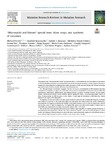Mostrar o rexistro simple do ítem
“Micronuclei and Disease” special issue: Aims, scope, and synthesis of outcomes
| dc.contributor.author | Fenech, Michael | |
| dc.contributor.author | Knasmueller, Siegfried | |
| dc.contributor.author | Knudsen, Lisbeth E. | |
| dc.contributor.author | Kirsch-Volders, Micheline | |
| dc.contributor.author | Deo, Permal | |
| dc.contributor.author | Franzke, Bernhard | |
| dc.contributor.author | Stopper, Helga | |
| dc.contributor.author | Andreassi, Maria-Grazia | |
| dc.contributor.author | Bolognesi, Claudia | |
| dc.contributor.author | Dhillon, Varinderpal S. | |
| dc.contributor.author | Laffon, Blanca | |
| dc.contributor.author | Wagner, Karl-Heinz | |
| dc.contributor.author | Bonassi, Stefano | |
| dc.date.accessioned | 2021-12-16T12:06:52Z | |
| dc.date.available | 2021-12-16T12:06:52Z | |
| dc.date.issued | 2021 | |
| dc.identifier.citation | Fenech, M., Knasmueller, S., Knudsen, L. E., Kirsch-Volders, M., Deo, P., Franzke, B., ... & Bonassi, S. (2021). “Micronuclei and Disease” special issue: aims, scope, and synthesis of outcomes. Mutation Research/Reviews in Mutation Research, 108384. doi.org/10.1016/j.mrrev.2021.108384 | es_ES |
| dc.identifier.uri | http://hdl.handle.net/2183/29149 | |
| dc.description.abstract | [Abastract] The purpose of the “Micronuclei and Disease” special issue (SI) is to: (i) Determine the level of evidence for association of micronuclei (MN), a biomarker of numerical and structural chromosomal aberrations, with risk of specific diseases in humans; (ii) Define plausible mechanisms that explain association of MN with each disease; (iii) Identify knowledge gaps and research needed to translate MN assays into clinical practice. The “MN and Disease” SI includes 14 papers. The first is a review of mechanisms of MN formation and their consequences in humans. 11 papers are systematic reviews and/or meta-analyses of the association of MN with reproduction, child health, inflammation, auto-immune disease, glycation, metabolic diseases, chronic kidney disease, cardiovascular disease, eleven common cancers, ageing and frailty. The penultimate paper focuses on effect of interventions on MN frequency in the elderly. A road map for translation of MN data into clinical practice is the topic of the final paper. The majority of reviewed studies were case-control studies in which the ratio of mean MN frequency in disease cases relative to controls, i.e. the mean ratio (MR), was calculated. The mean of these MR values, estimated by meta-analyses, for lymphocyte and buccal cell MN in non-cancer diseases were 2.3 and 3.6 respectively, and for cancers they were 1.7 and 2.6 respectively. The highest MR values were observed in studies of cancer cases in which MN were measured in the same tissue as the tumour (MR = 4.9–10.8). This special issue is an important milestone in the evidence supporting MN as a reliable genomic biomarker of developmental and degenerative disease risk. These advances, together with results from prospective cohort studies, are helping to identify diseases in which MN assays can be practically employed in the clinical setting to better identify high risk patients and to prioritise them for preventive therapy. | es_ES |
| dc.language.iso | eng | es_ES |
| dc.relation.uri | https://www.sciencedirect.com/science/article/pii/S1383574221000211?via%3Dihub | es_ES |
| dc.rights | Atribución-NoComercial-SinDerivadas 3.0 España | es_ES |
| dc.rights.uri | http://creativecommons.org/licenses/by-nc-nd/3.0/es/ | * |
| dc.subject | Cancer | es_ES |
| dc.subject | Cardiovascular disease | es_ES |
| dc.subject | Inflammation | es_ES |
| dc.subject | Ageing | es_ES |
| dc.subject | Micronuclei | es_ES |
| dc.subject | Disease | es_ES |
| dc.title | “Micronuclei and Disease” special issue: Aims, scope, and synthesis of outcomes | es_ES |
| dc.type | info:eu-repo/semantics/article | es_ES |
| dc.rights.access | info:eu-repo/semantics/openAccess | es_ES |
| UDC.journalTitle | Mutation Research/Reviews in Mutation Research | es_ES |
| UDC.volume | 788 | es_ES |
| UDC.issue | 108384 | es_ES |
| dc.identifier.doi | doi.org/10.1016/j.mrrev.2021.108384 |






